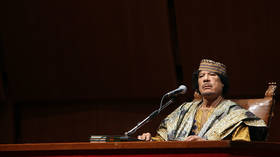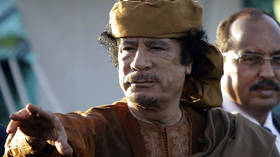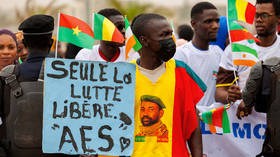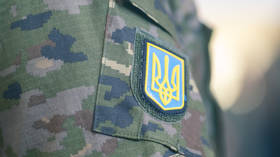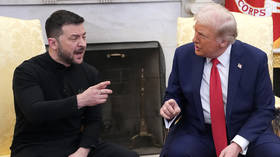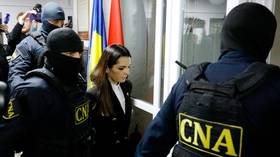13 years ago a NATO operation killed African civilians: Will the bloc ever be held responsible?
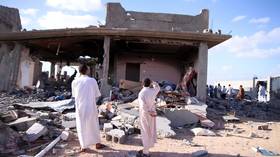
This August marks 13 years since the bloodiest month for Libyan civilians in the NATO air campaign against the legitimate Libyan government of the late Muammar Gaddafi. On October 20, 2011 Gaddafi himself was killed.
Yet to date neither the military alliance nor successive Libyan governments have acknowledged the fact that civilians, including women and children, were killed in at least six Libyan cities: Tripoli, Zlitin, Majuer, Bani Walid, Sirte and Adjdabia.
The bereaved families are still searching for answers to simple questions: why their loved ones were killed and who actually killed them?
How it all started
On February 15, 2011, small demonstrations happened in Al Bayda, Derna and other eastern cities, culminating in Benghazi before spreading to Libya’s western region in Tripoli, Misrata and Zawia.
Within days what were peaceful demonstrations, with legitimate demands, turned into an armed rebellion with scores of armed rebels, many of whom were former terrorists, coming from outside the country, taking up arms and attacking police stations and military barracks.
While the regime and its loyalists responded with counter-demonstrations and use of limited force in Benghazi, they resorted to more force elsewhere, including live ammunition, to counter what appeared to be an armed rebellion threatening the stability of the country.
The public eruption came after similar events in Tunisia and Egypt, Libya’s western and eastern neighbours respectively. Tunisian President Zine al-Abidine Ben Ali was forced to flee the country and seek refuge in Saudi Arabia where he died in 2019. Egypt’s Hosni Mubarak had to resign in the face of huge demonstrations.
In both cases the West attempted to save both leaders: in Tunisia, France offered support to the security forces, while in Egypt, the United States called on Mubarak to share power but not to step down.
In Libya it was a different story altogether, with Western countries including France, the US and United Kingdom supporting the rebellion even when it was still unclear what was going on inside the country. On February 25, 2011, barely a week after the protests started, then French President Nicolas Sarkozy called on Gaddafi to resign.
The Libyan revolt, later known as the Libyan Revolution, reached the halls of the United Nations Security Council (UNSC), which in the space of 19 days adopted two resolutions that made the situation even worse and plunged Libya into lawlessness that continues to persist.
On February 26, the council adopted resolution 1970 referring the situation to the International Criminal Court (ICC), imposing an arms embargo on the Libyan government (not the rebels) and banning top Libyan officials from traveling abroad.
Further complicating the situation, the UNSC adopted resolution 1973 on March 17, imposing a no-fly zone over Libya and calling on all UN member states to “take all necessary measures, to protect civilians and civilian populated areas” under alleged threat of attack by government forces. This resolution made it presumably legal for any country to intervene militarily in Libya as long as it notified the UN of its actions. Concealed under the general principle of Responsibility to Protect (R2P) the Western countries were seeking to force regime change and did not necessarily care about civilians. Even today the legality of both UNSC resolutions is still controversial and rejected by many legal experts. Professor Hugh Roberts of the International Crisis Group questioned the validity of the R2P argument in his article ’Who Said Gaddafi Had to Go?’
The 1973 resolution implied, among other things, supplying the rebels with weapons, ammunition and secret agents to help them against government forces.
By the end of February 2011, Libya was engulfed in civil war encouraged and assisted by the West. In fact, before the UNSC met in New York to debate the unfolding crisis, many Western countries had already been meddling in Libya’s internal affairs. Prior to the launch of NATO air raids on Libya, France and the UK had already been involved in the Libyan crisis using special forces, secretly channelling arms and providing intelligence to the rebels who had already taken over most of the eastern region by then.
Furthermore, when both UNSC resolutions were passed, the UN Human Rights Council had yet to send its fact-finding mission to Libya to evaluate the situation on the ground. This meant the only information available to the UNSC was the sort of propaganda and distorted facts being pumped out by biased major media networks including Al-Jazeera, BBC and CNN. However, in theory, the UNSC is supposed to act only based on verifiable facts it receives from unbiased and independent sources.
NATO invasion
UNSC resolution 1973 not only gave the green light to any country to do whatever it likes to “protect” civilians in Libya, but also allowed countries to join forces to achieve the same end. NATO was never authorised by the UNSC to intervene in Libya, but paragraph 4 of resolution 1973 permitted UN member states to act unilaterally or through “regional organizations or arrangements” and the alliance used this as legal authorization to bomb Libya to reinforce the no-fly zone. The UN, deceptively, authorized NATO to invade a North African country for the first time since France was defeated in Algeria in 1962.
On March 31, 2011, NATO launched what it called Operation Unified Protector, which lasted through October 31, during which time the bloc employed some 8,000 troops and 260 air assets, including the latest fighter jets, and at least 21 naval assets including submarines.
When the biggest military alliance in human history ended its operation it had conducted over 26,000 sorties, including 9,000 strike sorties, at an estimated cost of over $1 million per month.
The military invasion of UN member Libya, disguised as humanitarian intervention to protect civilians, led to widespread destruction of Libya’s infrastructure and killed hundreds of civilians and thousands of soldiers.
Civilian causalities
While no precise figures on how many civilians NATO killed in Libya are available, many international organizations have documented many cases where civilians were killed – mostly in their sleep. Human Rights Watch’s (HRW) report on civilian deaths said that NATO “air strikes killed at least 72 civilians, one-third of them children.” The report included testimonies of survivors and visits to bombed houses and other civilian structures.
In March 2012, Amnesty International (AI) published its ‘The Forgotten Victims of NATO Strikes’ report, putting the number of civilian deaths at around 55 people. Both organizations agree that they did not receive any data from NATO, nor did they find any justifications, legal or otherwise, to explain the number of civilian deaths. They also emphasize that the military alliance refused to investigate or explain why civilians were killed, while denying killing a single civilian.
Both reports are neither conclusive nor final, since they both came shortly after the airstrikes occurred and investigators from both rights groups did not visit all the locations where civilians were killed. While their counts are likely accurate they are in fact less than one third of the estimated total number of Libyan civilians killed by NATO airstrikes.
Updated figures
In early 2021, Airwars, an NGO watchdog focused on civilian casualty counts, published a new report based on a more thorough and detailed investigation backed up by hundreds of eyewitness accounts, documents and personal testimonies of survivors. I happened to help Airwars produce the report, which estimated that between 223 and 403 civilians were killed, including women and children. In my book published in Arabic in 2018, I estimated the number of civilian deaths as anywhere between 240 and 350.
Danish bombings
In January 2024, The Guardian collaborated with Airwars and others to investigate whether Danish jets killed any civilians in Libya as part of the NATO campaign. It found Denmark’s defence ministry knew, as long ago as 2012, that two of its F-16s bombed at least two locations – widely reported at the time – where 12 civilians were killed in Surman, 60km west of Tripoli and another two in Sirte, 500km east of the capital. Both cases where reported on by the UN, HRW and AI in 2011.
The Danish Defence Ministry covered up the findings until it was forced, under the freedom of information act, to acknowledge them in December 2023.
The airstrike in Surman on June 20, 2011, targeted Khaled Al-Hamedi’s home, killing his two young children, their mother and another four children who happened to be with them in the house along with six adults. The first strike that killed civilians happened a day earlier, on June 19, 2011, in Souk Al-Juma district, east of the capital, killing five members of the Al-Ghrari family including two children a few months old.
Bloody August
August 2011 saw at least six different airstrikes in three Libyan towns, killing nearly 60 civilians and injuring over 100. They died when a strike hit a large residential compound in a little village called Majure southwest of Zlitin, some 150km east of Tripoli. Among the dead were two newly born girls named Libya and Majure, respectively.
Neither NATO nor the Western governments that came to power in Libya after 2011 have ever admitted any responsibility for the civilian causalities and destruction of private properties. Even today, NATO still denies it killed civilians in Libya while authorities in Libya do not even discuss the issue.
Mr. Al-Hamedi, who is leading the Association of Victims of the NATO War on Libya, filed a case against NATO in Belgium, where the alliance has its head-quartiers, in 2012. But in 2017 the Belgian Court of Appeal in Brussels rejectedthe case on the basis that NATO enjoys diplomatic immunity and cannot be prosecuted.
However, neither Mr. Al-Hamedi nor any of the other bereaved families is giving up their search for answers. Mohamed Al-Ghrari, who lost five of his family in Souk Al-Juma, told RT: “I only want to know why my family members were killed while sleeping?” The equally bereaved Mustafa Al-Morabit, who lost his wife and two children in Zlitin, said, “I will not give up until one day I find out who killed my family and why.”
Whose fighter jet bombed which site?
Countries like Jordan, Qatar and United Arab Emirates also participated in the alliance’s destruction of Libya. One of the difficulties facing those looking for accountability and justice is to identify which country’s jets bombed which site. This is why identifying Denmark is very important. If a Danish court, where Mr. Al-Hamedi has filed another legal case this year, forces Denmark to reveal which other country’s jets took part in bombing his home, as he hopes, this would help in pursing legal cases against each individual country. Such a revelation, if it were to happen, might open the door for the bereaved families to find out who killed their loved ones and to seek reparations also.
The statements, views and opinions expressed in this column are solely those of the author and do not necessarily represent those of RT.
